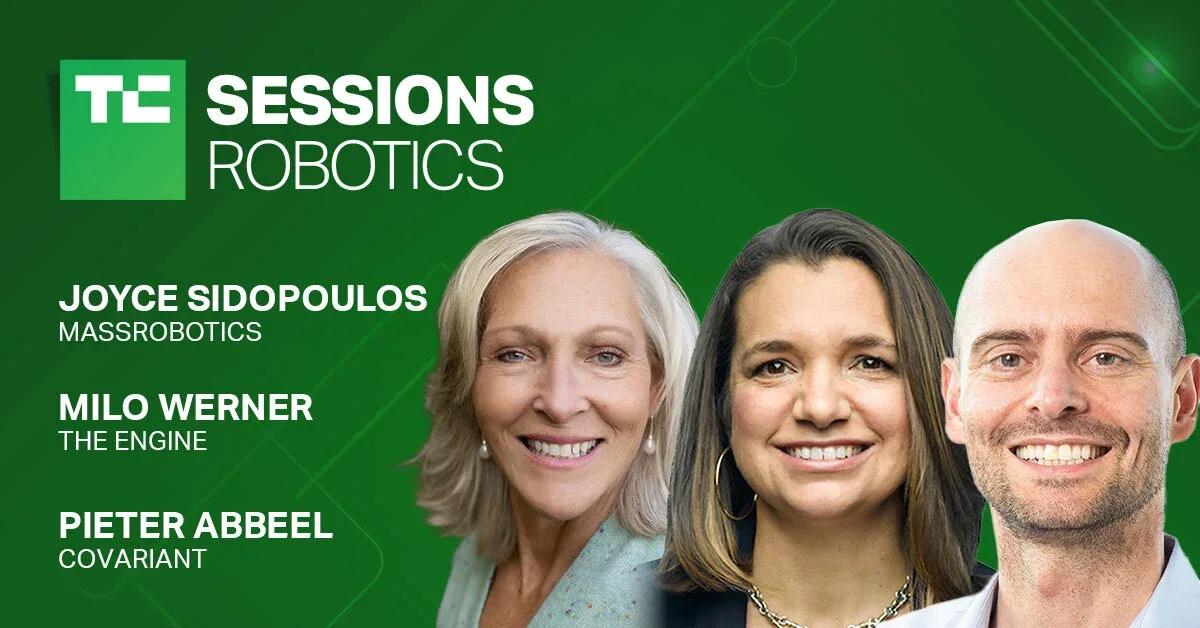You’ve had a brilliant idea. Great! Even better: It’s a breakthrough! You’ve proven that your new, cutting-edge idea actually works. You’ve presented your technology at conferences and you’ve published your findings in respected journals. Repeatedly, you’ve received feedback that your technology could change the game for an industry.
So…what next? How does great technology go from “cage to stage,” i.e. from an academic or research context to viable commercial production?
Recently, Covariant Co-Founder, President, and Chief Scientist, Pieter Abbeel, spoke on this topic for TechCrunch Sessions: Robotics, along with Milo Werner, General Partner at The Engine, and Joyce Sidopoulos, Co-Founder and VP of Programs & Community at MassRobotics. The panelists offered expert insight, having taken products developed in research contexts to market, and helped others do the same.
Let’s take a look through some of the key themes and insights.

Consider the real-world environment
Working in the lab, the main focus is just trying to get your prototype working.
“Often you can write a paper that gets a lot of visibility and excitement for showing something for the first time — it can work! Then you go to something in production… and all of a sudden, it’s not the fact that you can make it work once that matters — it’s the consistency, having it essentially always work.”
In the wider world, “your equipment isn’t going to be as rigorously monitored,” said Werner. “[You have to understand] how to adjust your process to be precise in a less precise environment.”
Sidopoulos agreed. “When the technologists are designing the product itself, they just want it to work, right?...But when you actually go to manufacturing, the manufacturer will say, we can’t put that board on top of that, we can’t assemble it that way.”
That’s why it’s important to consider the context in which the technology will be operating from the start. And you should expect to do multiple iterations, based on what you find.
Hit the road. Continue testing. Keeping honing in.
At Covariant, one of the ways we learned what companies were actually looking for in terms of robotic automation was simply getting out there and talking to people across various industries.
“We met with about 200 companies in the first six months to understand, if they got a robot in their facility what would that robot be doing for them?” said Abbeel. “[We asked ourselves], how realistic is it for us to deliver a robot for them in the near term that would do what they’re asking for? If we delivered that robot tomorrow, would you be excited about it, or would it not fit with your plans?”
After gathering feedback, leaders at Covariant could see that the warehousing space was a place where people were excited to have robots with much wider capabilities than pre-programmed robots could offer. There was a lot of commercial and technological opportunity in bringing the next generation of robotic automation to warehousing.
Sidopoulos expanded on this idea, advising tech founders to focus on getting one solution working.
“Solve a problem for somebody…. Make sure there’s a customer who wants that problem solved.”
Hit the road. Continue testing. Keep honing in.
At Covariant, one of the ways we learned what companies were actually looking for in terms of robotic automation was simply getting out there and talking to people across various industries.
“We met with about 200 companies in the first six months to understand, if they got a robot in their facility what would that robot be doing for them?” said Abbeel. “[We asked ourselves], how realistic is it for us to deliver a robot for them in the near term that would do what they’re asking for? If we delivered that robot tomorrow, would you be excited about it, or would it not fit with your plans?”
After gathering feedback, leaders at Covariant could see that the warehousing space was a place where people were excited to have robots with much wider capabilities than pre-programmed robots could offer. There was a lot of commercial and technological opportunity in bringing the next generation of robotic automation to warehousing.
Sidopoulos expanded on this idea, advising tech founders to focus on getting one solution working.
“Solve a problem for somebody…. Make sure there’s a customer who wants that problem solved.”
Again, it’s important to test the feasibility of that idea in the field. At MassRobotics, founders will often focus on an industry, such as construction, only to find that when the center brings in experts from that field for consultation, they’ll say, “We don’t need what you were solving, solved. We need this solved instead.”
Testing the idea helps you to find success and gives you the ability to build a story around a customer that’s actively using and succeeding with your technology. Then pivot to another case – but really solve one thing the right way first.
Werner emphasized thinking of your technology as a platform that can be applied to a wide variety of industries and then starting with a partner to de-risk your technology.
For instance, when Werner was with Tesla, they partnered with Toyota to build the battery pack for the RAV4 SUV, which eventually became the same battery pack for the Model S. It’s important to leverage partnerships like that – though all three panelists agreed it’s also critical not to get lost within the workings of a larger company.

Photo credit: Ruchindra Gunasekara on Unsplash
Be curious and open to other people’s strengths
One big challenge early on for startups is knowing when – and how – to bring on the right people with the right skills and expertise. Taking technology to market means understanding what that market is, how to craft your story in a way that will resonate with it, and how to get that story out there. And that takes bringing in expertise beyond the technological.
“Moving to the business space is team-oriented, and you are only as strong as your team,” said Werner.
To build that team, “have a natural curiosity about everything, not just…the technology,” suggested Abbeel. “Be curious about, what’s the best way to talk to customers? What’s the best way to do marketing? When you’re curious about that and excited, it’s much easier to attract really good people that are experienced in that space.”
“A lot of times, the co-founders are passionate about what they’re doing, and they’re doing it…because they’ve encountered a challenge in the world that they feel they can fix,” said Sidopoulos. “But then you really have to bring in a business-focused person because, how do you sell this thing? How do you put it into a pitch deck? That’s not what you’re taught when you’re in engineering school."
The panelists emphasized the importance of making those connections in advance of when you’ll need them. The Engine, for instance, hosts a program called Blueprint for grad students, post-docs, research scientists, and faculty members to explore what it would look like to have these commercial opportunities. A part of that is considering when to hire, which is decidedly in advance of when you actually need that skillset.
Similarly, MassRobotics has a program that brings together more experienced founder-CEOs with those who are just starting out to brainstorm and offer suggestions.
Finding, attracting, and keeping outside talent is key in the early days, so know what you have to offer. “When these startups need the person, they don’t have the funding,” said Sidopoulos. “What kind of deals can you make that can attract them? Equity?”
From cage to stage
Cutting-edge technology can change the world – but it can only do so if it makes it from “cage to stage.” Doing so requires humility, curiosity, research, and the ability to keep your core vision in mind while still being flexible. Here’s to all of the founders who have done it, and here’s to all to come! Thank you again to Pieter Abbeel, Milo Werner, and Joyce Sidopoulos for offering up their expertise, and to TechCrunch for hosting!
From cage to stage
Cutting-edge technology can change the world – but it can only do so if it makes it from “cage to stage.” Doing so requires humility, curiosity, research, and the ability to keep your core vision in mind while still being flexible. Here’s to all of the founders who have done it, and here’s to all to come! Thank you again to Pieter Abbeel, Milo Werner, and Joyce Sidopoulos for offering up their expertise, and to TechCrunch for hosting!
